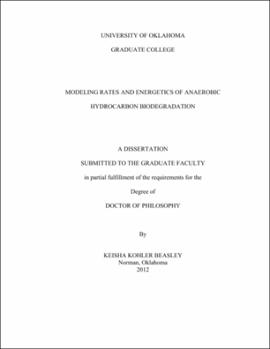| dc.contributor.advisor | Nanny, Mark A | |
| dc.creator | Beasley, Keisha Kohler | |
| dc.date.accessioned | 2019-04-27T21:29:41Z | |
| dc.date.available | 2019-04-27T21:29:41Z | |
| dc.date.issued | 2012 | |
| dc.identifier | 99233700702042 | |
| dc.identifier.uri | https://hdl.handle.net/11244/318823 | |
| dc.description.abstract | Hydrocarbons are ubiquitous in the environment, originating from both natural and refined sources and are an important class of compounds because of their role in the world's energy requirements, their toxicity, and their direct impact on the chemistry of the troposphere. Anaerobic biodegradation has been shown to be a significant process by which hydrocarbons are attenuated in contaminated environments, geothermal seeps, and oil and gas reservoirs. However, there is a need for more information to answer questions about the microorganisms, the mechanisms, and the conditions involved in these metabolic conversions. The purpose of the work in this dissertation is to contribute to the knowledge gap in two ways: 1) by developing a model that predicts substrate loss rates, and 2) by modeling the energetics of a mechanism with broad applicability in anaerobic hydrocarbon biodegradation. | |
| dc.description.abstract | In the first study (Chapter 2), calculated chemical properties were used as tools in the prediction of rate data. Polarizability and spin density of metabolites were correlated with the extent of anaerobic biodegradation of alkylbenzenes to develop a model that estimates substrate loss rates. A strong correlation was discovered which suggested that the stability of the reaction intermediates affected the rate of biodegradation. The findings help form a basis for predicting relative rates and using theoretical chemistry to describe observed phenomena in real world systems. In the next study (Chapter 3), quantum chemical calculations were performed to model the energetics of a theoretical reaction of anaerobic oxidation of methane. The resulting potential energy surface for the initial reaction was created and the results suggested the reaction is exothermic (-11.2 kcal/mol) and that the addition of methane to fumarate is calculated to be the rate-limiting step (25.0 kcal/mol). The relative inertness of methane makes it an ideal model substrate in defining the limits of energy barriers and minimal energy requirements for anaerobic metabolism. | |
| dc.description.abstract | The results in these studies provide information that advances our understanding of anaerobic hydrocarbon biodegradation. Ultimately, this information can be used to address questions about mechanism preferences, substrate preferences, biodegradation rates, and energy requirements for conversions in systems worldwide. | |
| dc.format.extent | 127 pages | |
| dc.format.medium | application.pdf | |
| dc.language | en_US | |
| dc.relation.requires | Adobe Acrobat Reader | |
| dc.subject | Hydrocarbons--Biodegradation | |
| dc.subject | Bioremediation | |
| dc.subject | Biodegradation | |
| dc.subject | Anaerobic bacteria | |
| dc.title | Modeling Rates and Energetics of Anaerobic Hydrocarbon Biodegradation | |
| dc.type | text | |
| dc.type | document | |
| dc.thesis.degree | Ph.D. | |
| ou.group | College of Engineering::School of Civil Engineering and Environmental Science | |
